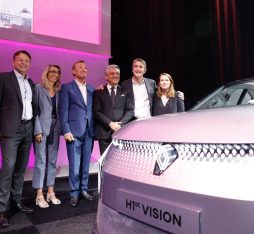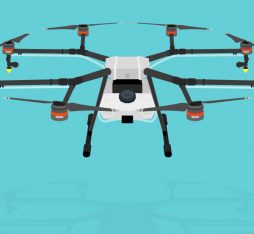“Drones are flying devices that are easily controllable, operated remotely and they can go virtually anywhere”, explains Bertrand Rojat, who heads up Open Innovation in the Technocentre and Orange Vallée. “Their main mission: observing. Fitted with ultra-high-definition cameras, drones collect and provide premium quality images, even for sites that are hard to access. A valuable feature for a wide range of professional situations, particularly in the agricultural and industrial sectors”.
Agridrone operators supporting environmentally responsible agriculture
“While satellite imaging is still widely used in agriculture, drones have become an essential tool for farmers”, notes Anne-Yvonne Halloux-Jahier, Editorial Manager. “Accurate to the nearest centimetre, they are used for mapping agricultural plots far more effectively than with satellites. By just flying over plots, they can capture increasingly fine-grained geotagged data covering temperature and soil analysis, as well as crop growth. Drones can also be used for spraying, contributing to what is known as precision agriculture”.
“In France, the agricultural sector is the leading user of drones: more than 8,000 farmers are already using their mapping services”, confirms Bertrand Rojat. “They call on agridrone operators, pilots who fly over their plots. Thanks to the images captured by the drones and reprocessed on the ground with our networks and data platforms, farmers are able to receive concrete advice on how to treat their soils, applying exactly the right dose of a particular fertiliser, identifying damage caused by wild animals, and so on. Drones are making it possible to adopt an ecologically and economically responsible approach for farming. A win-win progress for people and the planet”.
Leading the field for more secure infrastructures
Alongside agriculture, infrastructure represents another key field for the use and application of drones. This covers all aspects relating to infrastructure security (inspection of sensitive sites, monitoring of projects, etc.).
On the ground, Orange is already using drones to carry out missions to inspect its radio masts, which are high points set up in areas that are difficult to access. France’s national rail company, the SNCF, is using drones to analyse the condition of its tracks… “Thanks to drones, economic operators are adopting a focus on improving the security of infrastructures, with a preventive and proactive maintenance approach”, explains Bertrand Rojat.
While serving as the “eyes of emergency workers” for urgent humanitarian and relief operations, drones are also a valuable ally for tourism professionals and even archaeologists or palaeontologists! Because, for marginal costs, drones can take photos of sites that are difficult to access. And what can we say about drone deliveries for our online purchases?
Drone flights subject to specific safety standards
The inventiveness of drone users is virtually unlimited. However, we must remember that drone use is strictly supervised: they operate in an air space that is covered by various safety standards. Flights within and beyond your line of sight are possible, but under clearly defined conditions. For instance, in France, flights over built-up areas require prior approval from the local police station. And drones are not allowed to fly at altitudes over 150 metres.
Drones are already packed with a range of impressive technologies, with sophisticated on-board electronics and aeronautical systems, giving them a very high level of stability, reliability and independent flight capabilities. Of course, their capabilities still need to be extended. Today, they can fly for about ten minutes. However, concepts based on solar panels and very light carbon structures are currently being researched. The aim is to achieve virtually non-stop flights in the future. The range for flights is also a key factor. Today, drones use WiFi connectivity, which gives them a flying distance of a few kilometres. Mobile networks – 4G today and 5G tomorrow – will make it possible to considerably extend their flight capabilities. Orange has already made concrete progress, with the world’s first ever 4G drone flight, demonstrating the relevance of this technology.
Are drones expected to become widespread?
“Today, there are a few thousand commercial drones in operation in a country like France. There will be many more in the future, and they will be more independent and no doubt increasingly specialised, with sizes adapted for their missions”, concludes Bertrand Rojat. “So much so that we can imagine an infinite range of uses…Positioning drones as an essential companion within an increasingly well connected relationship between people and their planet”.








